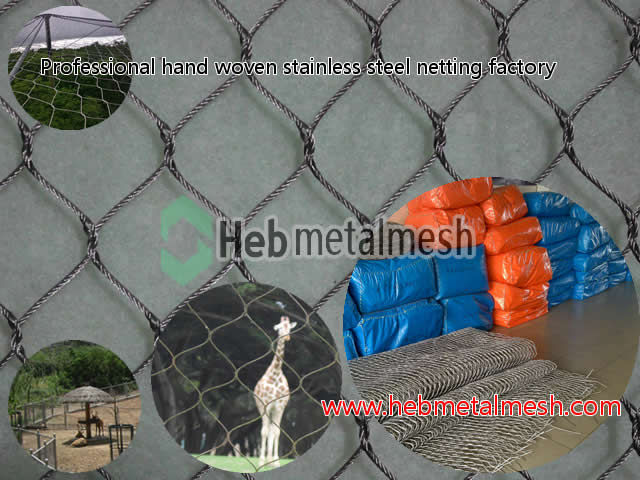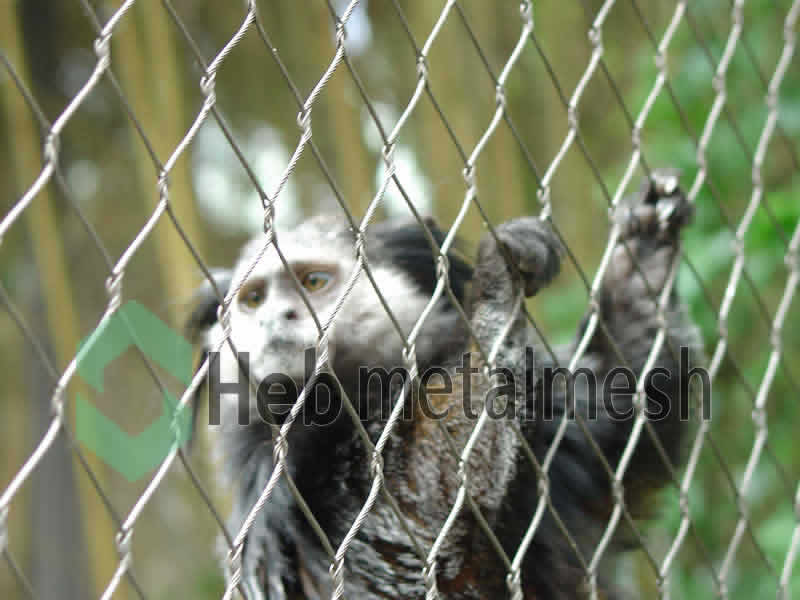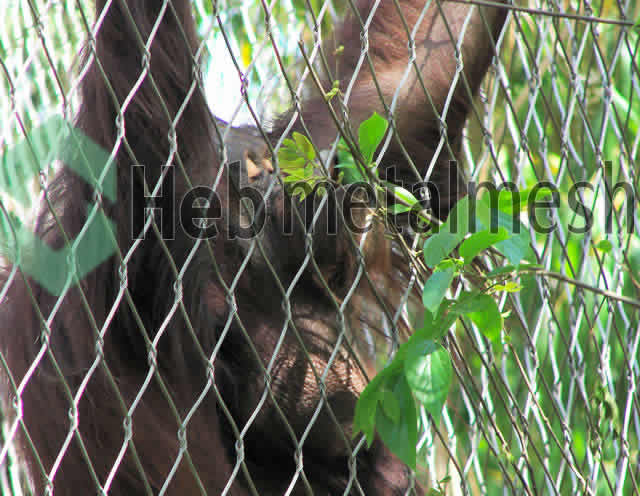Introduction to Stainless Steel Netting for Deer
Deer management and protection have become essential practices for wildlife enthusiasts and landowners alike. One of the most significant advancements in creating secure enclosures for these animals is the use of stainless steel netting. This material not only provides a robust barrier against potential predators and escape attempts but also proves to be an environmentally responsible choice. Stainless steel netting for deer is crafted to withstand various challenges posed by its surroundings, ensuring both safety and longevity.
The durability of stainless steel netting is one of its standout characteristics. Unlike traditional fencing materials, stainless steel exhibits impressive resistance to rust, corrosion, and wear over time. This durability means that deer enclosures made with stainless steel can effectively endure harsh weather conditions, decreasing the frequency of repairs or replacements. Furthermore, the strength of this material significantly reduces the risk of deer breaking through or damaging the enclosure, thereby maintaining a secure environment for the animals.
Additionally, using stainless steel netting for deer enclosures encourages a safe and healthy habitat for the animals. By containing deer within designated areas, landowners can manage their populations more effectively and shield them from potential dangers, such as vehicular traffic or overgrazing in vulnerable regions. Enclosures also enable proper feeding and breeding management, enhancing the overall well-being of the deer. Overall, selecting stainless steel netting as a fencing option significantly contributes to the management of deer in a variety of environments. The material’s reliability and performance are key factors, making it a preferred choice among those dedicated to the careful stewardship of wildlife.
Why Choose Stainless Steel for Deer Fencing
When it comes to creating effective and long-lasting deer enclosures, choosing the right material for netting is crucial. Stainless steel netting stands out against traditional options such as plastic or wood, primarily due to its exceptional properties and benefits. One of the key advantages of stainless steel is its corrosion resistance, particularly in grades 304 and 316. These stainless steel grades are less susceptible to rust and deterioration, ensuring that the netting retains its structural integrity even in humid or wet environments.
Durability is another significant factor that makes stainless steel netting a preferred choice for deer fencing. Unlike plastic netting, which can become brittle and break over time, or wood that may rot or warp, stainless steel offers an extended lifespan. This durability means that the initial investment in stainless steel netting will pay off over time with minimal maintenance costs and replacement needs.
Furthermore, stainless steel netting is designed to withstand harsh weather conditions, including snow, rain, and extreme temperatures. This resilience ensures that deer enclosures maintain their functionality regardless of seasonal changes or extreme weather events. Adequately featuring stainless steel netting not only enhances the security of the enclosure but also supports the overall health and safety of the deer within it.
Another important consideration is the aesthetic appeal of stainless steel. It provides a clean and professional appearance that blends well with various environments, enhancing the landscape rather than detracting from it. By investing in stainless steel netting for deer fencing, property owners can ensure a robust solution that meets their needs for both functionality and visual appeal.
Understanding Different Types of Stainless Steel Netting
When it comes to selecting netting for deer enclosures, the grade of stainless steel used is a critical factor. Two of the most commonly utilized grades are 304 and 316 stainless steel, each possessing unique properties that cater to different applications and environments.
The 304 stainless steel netting is widely favored for its excellent balance of strength, ductility, and resistance to rust and corrosion. It is formulated with a composition of approximately 18% chromium and 8% nickel, which provides good corrosion resistance in a variety of environments. Though it can withstand some exposure to moisture, it may not be the best choice for areas with high salinity or more extreme conditions. For deer enclosures in relatively mild climates or less corrosive environments, 304 stainless steel netting serves as an economical option, balancing durability and cost-effectiveness.
On the other hand, 316 stainless steel netting is designed for more demanding environments. It contains an additional 2% molybdenum, granting it superior resistance to corrosion, particularly in marine settings or areas with higher levels of chloride, such as coastal regions. This enhanced corrosion resistance makes 316 stainless steel netting ideal for long-term deer fencing solutions, particularly in adverse weather conditions where durability is of utmost concern.
In terms of strength, both grades offer substantial tensile strength, making them suitable for containing deer effectively. However, when selecting the appropriate type of netting for deer fencing, one should consider factors such as the local climate, exposure to chemicals, and budget constraints. Ultimately, understanding the distinct properties of 304 and 316 stainless steel will assist in choosing the most suitable netting for deer enclosures, ensuring that the chosen material meets both practical needs and long-term durability requirements.
Custom Roll Sizes for Optimal Fit
When considering netting for deer enclosures, the ability to customize roll sizes is crucial. Standard stainless steel netting roll dimensions typically reach a maximum size of 20′ x 100′. This dimension provides a substantial area of coverage, suitable for many applications, particularly for larger enclosures. However, different projects may have varying requirements, leading to the need for custom sizes that can precisely match specific spatial constraints or unique shapes of the area being enclosed.
Customers can request customized roll sizes, ensuring that they obtain netting for deer that best fits their individual circumstances. The benefits of opting for custom sizes are multifold. Firstly, avoiding excess material that would go unused is both cost-effective and environmentally sound. Secondly, a tailored fit can enhance the structural integrity of the enclosure, reducing potential vulnerabilities where deer might attempt to escape or where predators could infiltrate the area. This adaptability not only contributes to the functionality of the enclosure but also to the safety of the animals contained within.
Additionally, providing precise measurements for custom orders allows manufacturers to minimize waste during production, ultimately leading to more sustainable practices. In turn, this efficiency can result in cost savings for the consumer, as more fiscal resources can be allocated to other necessary elements of wildlife management, such as maintenance or habitat enrichment.
Overall, the option to choose custom roll sizes for stainless steel netting offers significant advantages for those looking to create secure and efficient deer enclosures. By working closely with suppliers, customers can find solutions that perfectly align with their project’s requirements, ensuring that their enclosures are both practical and effective in keeping deer safe and secure.
Installation Tips for Stainless Steel Netting
Installing stainless steel netting for deer enclosures requires careful planning and execution to ensure effectiveness and durability. The first step is proper site preparation, which involves clearing the area of any debris, vegetation, and obstacles that could affect the installation process. It’s essential to assess the ground conditions and identify any potential hazards, such as rocks or roots, which may interfere with securing the netting. A level surface will promote the structural integrity of the enclosure.
Next, it is important to measure the area accurately to determine the amount of stainless steel netting required. The netting should ideally extend slightly above ground level to prevent deer from attempting to jump over. When determining fence height, consider the size and behavior of the deer species in your area, as some may require taller structures. Ensure that you account for the width and pull strength of the netting, as these factors will dictate the support structure’s design needed to maintain its tension and prevent sagging over time.
Securing the netting properly is crucial for its long-term performance. Start by fastening the bottom of the netting to the ground, using stakes or anchors, which helps to prevent deer from digging underneath. The netting should be stretched tightly along the support posts without excessive slack, as this will reduce the risk of deer getting caught or pushing through. Installing additional supports and cross-bracing can improve stability and tension, especially in areas exposed to high winds or heavy snowfall.
Finally, ensure that all safety standards are met throughout the installation process. This includes using appropriate materials, tools, and protective gear during the setup. Regular inspections and maintenance of the stainless steel netting will help to identify wear and potential vulnerabilities, ensuring that your deer enclosure remains safe and secure over time. In conclusion, a well-executed installation of stainless steel netting can significantly enhance the protection of deer while also preserving their natural behavior and habitat.
Maintenance of Stainless Steel Netting
Proper maintenance of stainless steel netting is essential for ensuring its longevity and effectiveness as a protective barrier for deer enclosures. Regular care and attention will help prevent significant wear and tear, allowing for the netting to remain durable and reliable for years to come. One of the first steps in maintaining stainless steel netting is to regularly inspect it for any signs of damage or weakness. This can include checking for rust, bent wires, or loose fittings that may compromise the integrity of the enclosure.
Cleaning is another crucial aspect of netting for deer. Over time, dirt, debris, and organic material can accumulate on the surface of the stainless steel. This buildup can lead to corrosion if not addressed promptly. To clean stainless steel netting, it is advisable to use a mild cleaning solution and a soft brush to gently scrub the surface. Avoid abrasive materials that could cause scratches, as these imperfections can become focal points for rust. Rinsing the netting with water after cleaning will help remove any residue from the cleaning solution.
In addition to regular inspections and cleaning, establishing a maintenance schedule can prove beneficial. Depending on the local environment, factors such as humidity, exposure to pollutants, and wildlife activity can influence how often maintenance is required. A good practice is to conduct thorough inspections at least twice a year, ideally in the spring and fall, to prepare for the changing seasons. These check-ups allow for the timely identification of any issues that may arise, enabling proactive replacements or repairs to be made without significant cost or effort.
By following these maintenance guidelines, deer enclosure owners can ensure that their stainless steel netting continues to provide safety and security for their deer populations, preserving the overall effectiveness and aesthetic of their enclosures.
Cost Considerations and Budgeting for Deer Netting
When it comes to investing in netting for deer, understanding the costs involved is critical. The price of stainless steel netting can vary widely based on several key factors. First, the size of the netting plays a significant role; larger areas requiring coverage will naturally incur higher costs. This is due to the increased amount of material needed to provide adequate protection around your deer facilities.
Another factor influencing the cost is the gauge of the netting. Generally, heavier gauges provide enhanced durability and strength, making them more effective at keeping deer secure. Although heavier gauge netting may have a higher initial price, it is essential to weigh this against potential long-term savings. A more robust option often translates into fewer replacements and repairs, ultimately benefiting your budget over time.
Customization options also impact pricing. Depending on the specific needs of your deer enclosure, you may require netting that meets particular specifications, such as mesh size or height. Custom solutions can lead to additional costs, which should be factored into your budget. A clear understanding of these requirements will allow for more accurate financial planning.
To effectively budget for your stainless steel netting project, it is essential to outline your requirements and obtain quotes from multiple suppliers. This approach not only allows you to compare prices but also to assess the quality offered. It is advisable to think of the purchase as a long-term investment. While the initial outlay may seem substantial, the longevity, maintenance-free nature, and effectiveness of high-quality netting for deer can contribute to substantial savings in the future. Allocating your budget appropriately and recognizing the inherent value of resilience and durability will ensure that you make a sound financial decision for your deer facilities.
Comparative Analysis: Stainless Steel vs. Alternative Materials
When it comes to constructing enclosures for deer, the choice of material plays a crucial role in ensuring durability, safety, and effectiveness. Among the various materials available, stainless steel netting stands out for several reasons. To comprehensively assess its advantages, it is essential to compare it with alternative fencing options such as vinyl, wood, and traditional metal.
Stainless steel netting is known for its exceptional strength and longevity. Unlike vinyl, which can become brittle over time and may break under pressure, stainless steel exhibits remarkable resistance to wear and environmental factors. Additionally, stainless steel is impervious to pests and degradation, making it an ideal choice for long-term use in deer enclosures. In contrast, wood may offer aesthetic appeal, but it often requires regular maintenance and treatment to protect against rot, termites, and other issues. Consequently, wood can incur significant costs over time in upkeep.
When evaluating traditional metal options, such as chain link fencing, one must consider the differences in safety and effectiveness. While chain link is generally more cost-effective upfront, it tends to lack the sturdiness and resilience of stainless steel netting, which is specifically designed to secure and protect larger animals like deer. Furthermore, conventional metal fencing can be subject to rust and corrosion, jeopardizing its structural integrity over time.
Furthermore, the adaptability of stainless steel netting allows for various configurations, catering to specific enclosure needs without compromising safety or functionality. Its smooth finish and precise manufacturing ensure minimal risk of injury to the deer, contrasting with the potentially sharp edges of other materials.
Through this comparative analysis, it becomes clear that while alternative materials may offer certain benefits, stainless steel netting provides a superior combination of durability, safety, and long-term value for deer enclosures.
Conclusion and Next Steps for Deer Enclosure Solutions
In summary, this guide has highlighted the numerous benefits of utilizing stainless steel netting for deer enclosures. Stainless steel netting is not only durable and resistant to the elements, but it also offers superior protection against predators while ensuring the safety and well-being of the deer. Its strength and longevity make it a prudent choice for anyone looking to establish or enhance a deer enclosure.
Additionally, the versatility of stainless steel netting allows for various applications, whether for a personal hobby farm, wildlife conservation efforts, or commercial farming. Its robust design contributes to maintaining a healthy environment for deer while minimizing the likelihood of escape. As outlined, the effective use of netting for deer ensures that both the deer and surrounding ecosystems thrive. Each of these advantages affirms that stainless steel netting is a worthwhile investment for any enclosure project.
For those interested in implementing this solution, the next steps are essential for a successful installation. Begin by assessing your specific enclosure requirements, including the size, location, and security needs. Depending on the scale of your project, it may be beneficial to consult with experts or existing users of stainless steel netting to gather insights and feedback on their experiences.
Once you have a clear understanding of your needs, exploring suppliers who can provide high-quality stainless steel netting is vital. Most suppliers offer a range of products tailored to different specifications and needs, so reaching out for quotes and additional information is advisable. By taking these steps, you will be well-equipped to enhance your deer enclosure with the advantages of stainless steel netting.
✅Goto deer fencing product page to choose best specifications…


